Organizational Behavior Report: Managing Diverse Teams and Conflicts
VerifiedAdded on 2021/09/22
|12
|2954
|58
Report
AI Summary
This report provides an in-depth analysis of organizational behavior principles, focusing on team dynamics, recruitment strategies, leadership styles, and conflict management within a diverse workforce. It begins with an introduction outlining the scope of the report, followed by sections on team effectiveness, selection methods, cultural leadership, and conflict resolution. The report emphasizes the importance of factors such as team member characteristics, group size, norms, synergy, leadership, and cohesiveness in building effective teams. It then explores various selection methods, including panel interviews, behavioral tests, and skill assessments. Furthermore, the report delves into the significance of cultural diversity and the role of leadership in fostering an inclusive environment, advocating for a mix of democratic and transformational leadership styles. Finally, it addresses group conflicts, their impact on workplace stress, and offers recommendations for managing conflicts and promoting continuous communication within the organization. The report concludes by synthesizing the key findings and providing actionable insights for effective organizational management.
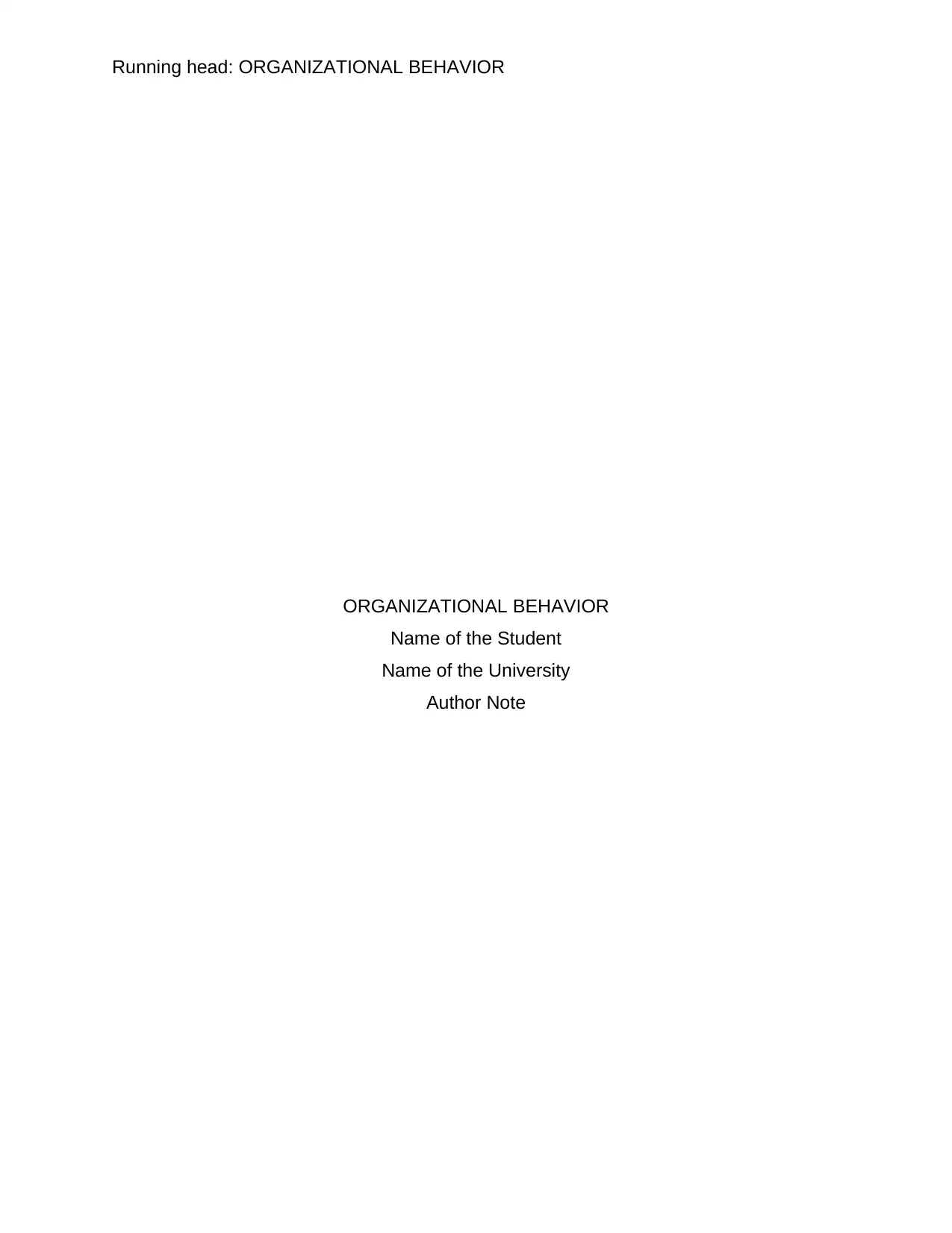
Running head: ORGANIZATIONAL BEHAVIOR
ORGANIZATIONAL BEHAVIOR
Name of the Student
Name of the University
Author Note
ORGANIZATIONAL BEHAVIOR
Name of the Student
Name of the University
Author Note
Paraphrase This Document
Need a fresh take? Get an instant paraphrase of this document with our AI Paraphraser
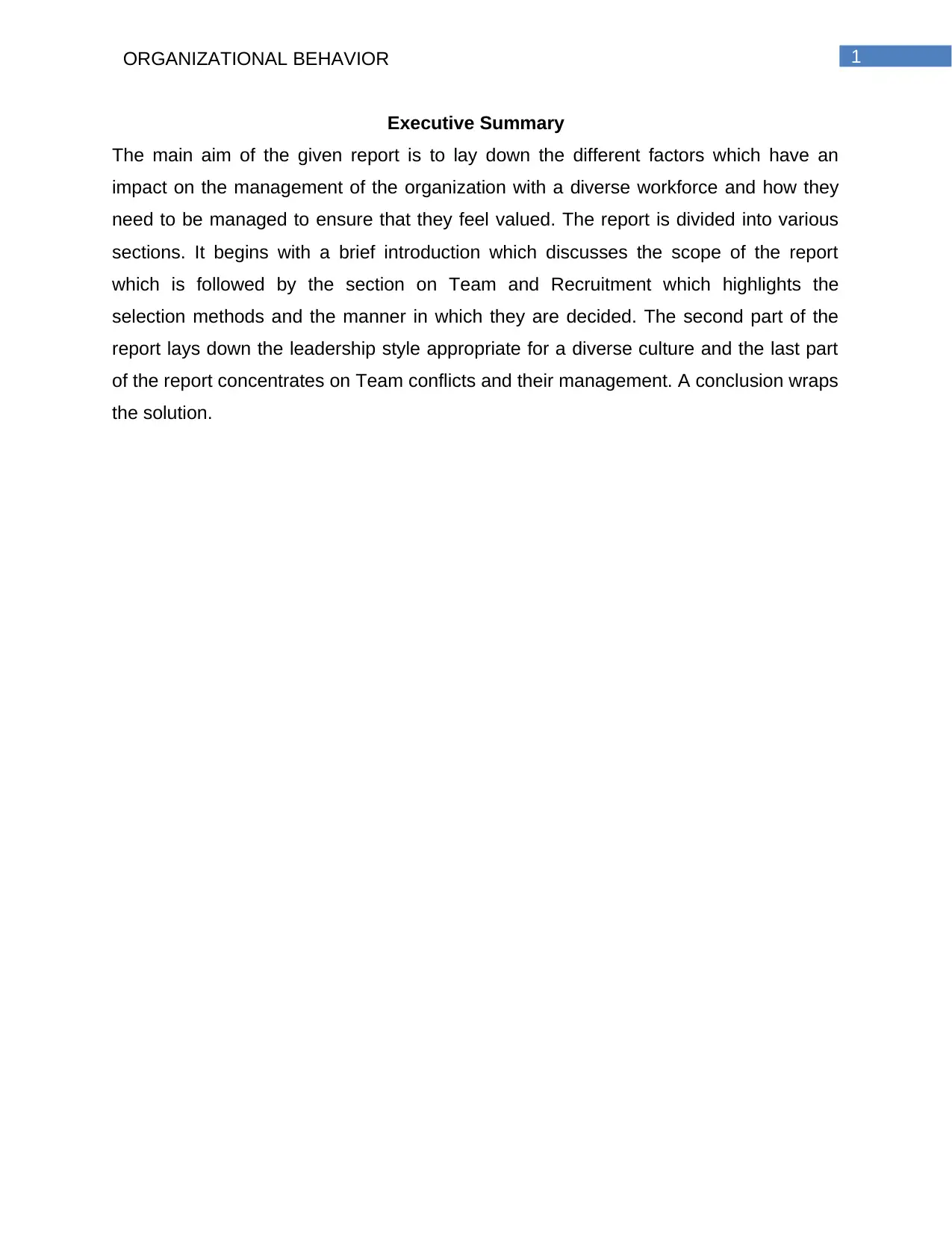
1ORGANIZATIONAL BEHAVIOR
Executive Summary
The main aim of the given report is to lay down the different factors which have an
impact on the management of the organization with a diverse workforce and how they
need to be managed to ensure that they feel valued. The report is divided into various
sections. It begins with a brief introduction which discusses the scope of the report
which is followed by the section on Team and Recruitment which highlights the
selection methods and the manner in which they are decided. The second part of the
report lays down the leadership style appropriate for a diverse culture and the last part
of the report concentrates on Team conflicts and their management. A conclusion wraps
the solution.
Executive Summary
The main aim of the given report is to lay down the different factors which have an
impact on the management of the organization with a diverse workforce and how they
need to be managed to ensure that they feel valued. The report is divided into various
sections. It begins with a brief introduction which discusses the scope of the report
which is followed by the section on Team and Recruitment which highlights the
selection methods and the manner in which they are decided. The second part of the
report lays down the leadership style appropriate for a diverse culture and the last part
of the report concentrates on Team conflicts and their management. A conclusion wraps
the solution.
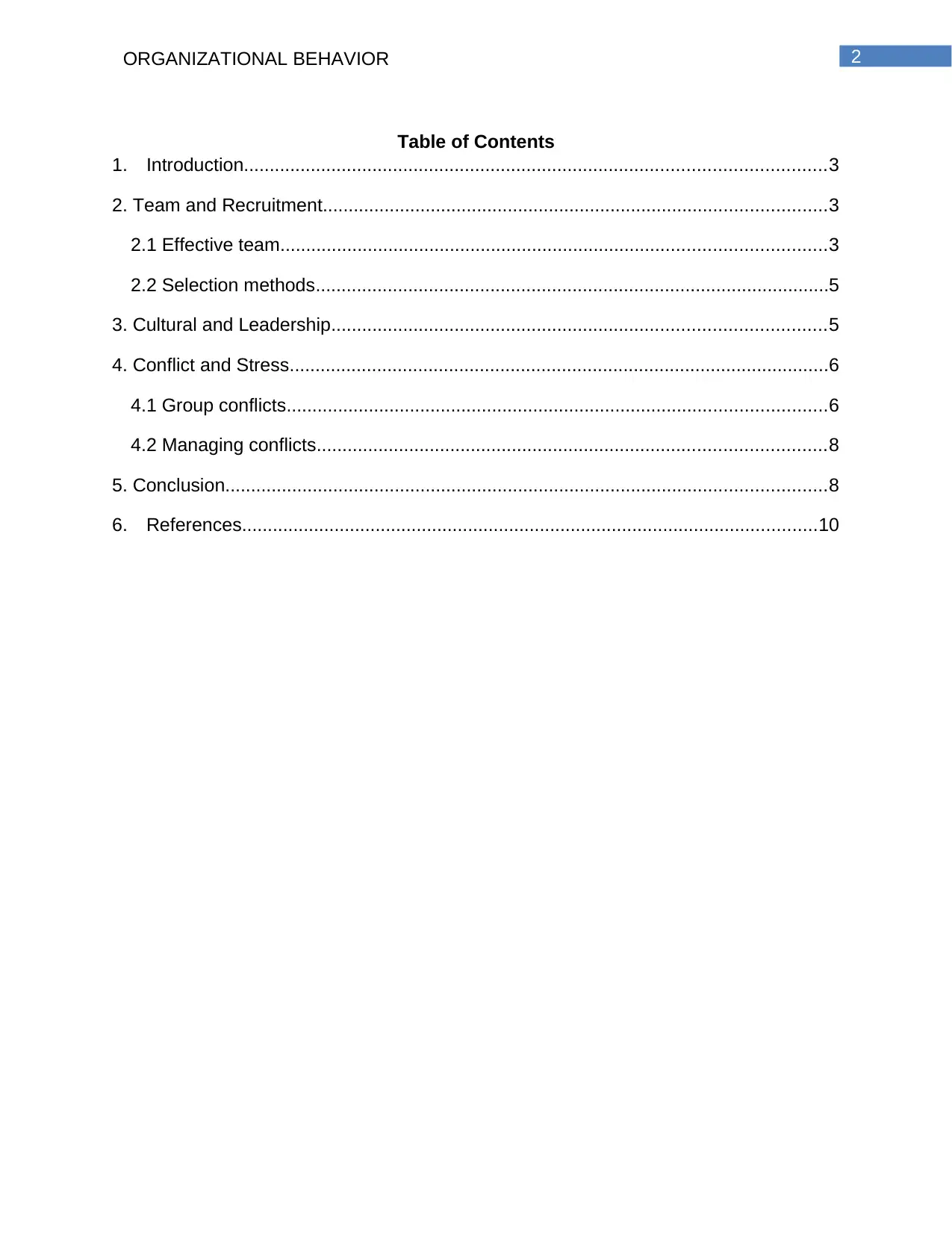
2ORGANIZATIONAL BEHAVIOR
Table of Contents
1. Introduction.................................................................................................................3
2. Team and Recruitment..................................................................................................3
2.1 Effective team..........................................................................................................3
2.2 Selection methods....................................................................................................5
3. Cultural and Leadership................................................................................................5
4. Conflict and Stress.........................................................................................................6
4.1 Group conflicts.........................................................................................................6
4.2 Managing conflicts...................................................................................................8
5. Conclusion.....................................................................................................................8
6. References................................................................................................................10
Table of Contents
1. Introduction.................................................................................................................3
2. Team and Recruitment..................................................................................................3
2.1 Effective team..........................................................................................................3
2.2 Selection methods....................................................................................................5
3. Cultural and Leadership................................................................................................5
4. Conflict and Stress.........................................................................................................6
4.1 Group conflicts.........................................................................................................6
4.2 Managing conflicts...................................................................................................8
5. Conclusion.....................................................................................................................8
6. References................................................................................................................10
⊘ This is a preview!⊘
Do you want full access?
Subscribe today to unlock all pages.

Trusted by 1+ million students worldwide
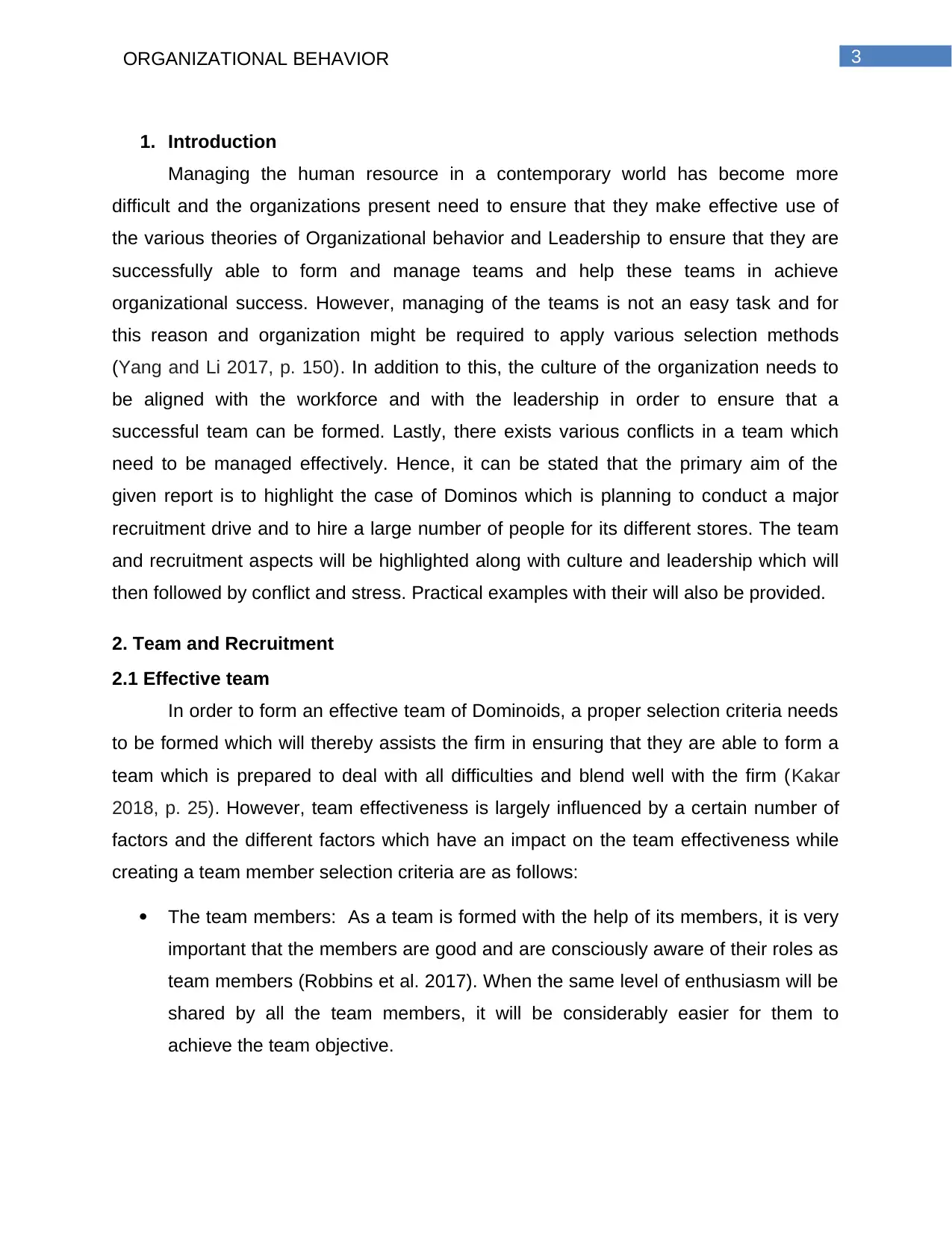
3ORGANIZATIONAL BEHAVIOR
1. Introduction
Managing the human resource in a contemporary world has become more
difficult and the organizations present need to ensure that they make effective use of
the various theories of Organizational behavior and Leadership to ensure that they are
successfully able to form and manage teams and help these teams in achieve
organizational success. However, managing of the teams is not an easy task and for
this reason and organization might be required to apply various selection methods
(Yang and Li 2017, p. 150). In addition to this, the culture of the organization needs to
be aligned with the workforce and with the leadership in order to ensure that a
successful team can be formed. Lastly, there exists various conflicts in a team which
need to be managed effectively. Hence, it can be stated that the primary aim of the
given report is to highlight the case of Dominos which is planning to conduct a major
recruitment drive and to hire a large number of people for its different stores. The team
and recruitment aspects will be highlighted along with culture and leadership which will
then followed by conflict and stress. Practical examples with their will also be provided.
2. Team and Recruitment
2.1 Effective team
In order to form an effective team of Dominoids, a proper selection criteria needs
to be formed which will thereby assists the firm in ensuring that they are able to form a
team which is prepared to deal with all difficulties and blend well with the firm (Kakar
2018, p. 25). However, team effectiveness is largely influenced by a certain number of
factors and the different factors which have an impact on the team effectiveness while
creating a team member selection criteria are as follows:
The team members: As a team is formed with the help of its members, it is very
important that the members are good and are consciously aware of their roles as
team members (Robbins et al. 2017). When the same level of enthusiasm will be
shared by all the team members, it will be considerably easier for them to
achieve the team objective.
1. Introduction
Managing the human resource in a contemporary world has become more
difficult and the organizations present need to ensure that they make effective use of
the various theories of Organizational behavior and Leadership to ensure that they are
successfully able to form and manage teams and help these teams in achieve
organizational success. However, managing of the teams is not an easy task and for
this reason and organization might be required to apply various selection methods
(Yang and Li 2017, p. 150). In addition to this, the culture of the organization needs to
be aligned with the workforce and with the leadership in order to ensure that a
successful team can be formed. Lastly, there exists various conflicts in a team which
need to be managed effectively. Hence, it can be stated that the primary aim of the
given report is to highlight the case of Dominos which is planning to conduct a major
recruitment drive and to hire a large number of people for its different stores. The team
and recruitment aspects will be highlighted along with culture and leadership which will
then followed by conflict and stress. Practical examples with their will also be provided.
2. Team and Recruitment
2.1 Effective team
In order to form an effective team of Dominoids, a proper selection criteria needs
to be formed which will thereby assists the firm in ensuring that they are able to form a
team which is prepared to deal with all difficulties and blend well with the firm (Kakar
2018, p. 25). However, team effectiveness is largely influenced by a certain number of
factors and the different factors which have an impact on the team effectiveness while
creating a team member selection criteria are as follows:
The team members: As a team is formed with the help of its members, it is very
important that the members are good and are consciously aware of their roles as
team members (Robbins et al. 2017). When the same level of enthusiasm will be
shared by all the team members, it will be considerably easier for them to
achieve the team objective.
Paraphrase This Document
Need a fresh take? Get an instant paraphrase of this document with our AI Paraphraser
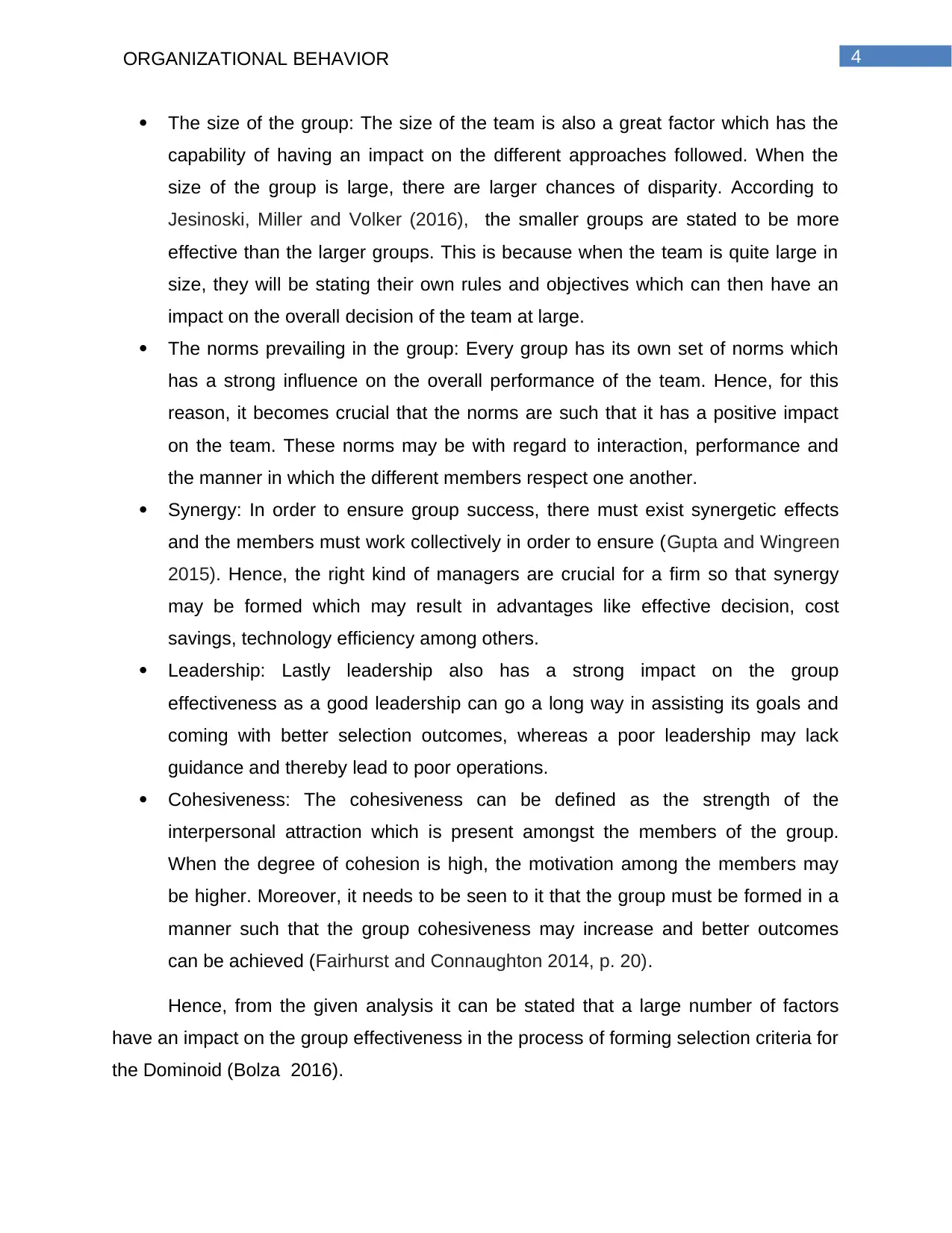
4ORGANIZATIONAL BEHAVIOR
The size of the group: The size of the team is also a great factor which has the
capability of having an impact on the different approaches followed. When the
size of the group is large, there are larger chances of disparity. According to
Jesinoski, Miller and Volker (2016), the smaller groups are stated to be more
effective than the larger groups. This is because when the team is quite large in
size, they will be stating their own rules and objectives which can then have an
impact on the overall decision of the team at large.
The norms prevailing in the group: Every group has its own set of norms which
has a strong influence on the overall performance of the team. Hence, for this
reason, it becomes crucial that the norms are such that it has a positive impact
on the team. These norms may be with regard to interaction, performance and
the manner in which the different members respect one another.
Synergy: In order to ensure group success, there must exist synergetic effects
and the members must work collectively in order to ensure (Gupta and Wingreen
2015). Hence, the right kind of managers are crucial for a firm so that synergy
may be formed which may result in advantages like effective decision, cost
savings, technology efficiency among others.
Leadership: Lastly leadership also has a strong impact on the group
effectiveness as a good leadership can go a long way in assisting its goals and
coming with better selection outcomes, whereas a poor leadership may lack
guidance and thereby lead to poor operations.
Cohesiveness: The cohesiveness can be defined as the strength of the
interpersonal attraction which is present amongst the members of the group.
When the degree of cohesion is high, the motivation among the members may
be higher. Moreover, it needs to be seen to it that the group must be formed in a
manner such that the group cohesiveness may increase and better outcomes
can be achieved (Fairhurst and Connaughton 2014, p. 20).
Hence, from the given analysis it can be stated that a large number of factors
have an impact on the group effectiveness in the process of forming selection criteria for
the Dominoid (Bolza 2016).
The size of the group: The size of the team is also a great factor which has the
capability of having an impact on the different approaches followed. When the
size of the group is large, there are larger chances of disparity. According to
Jesinoski, Miller and Volker (2016), the smaller groups are stated to be more
effective than the larger groups. This is because when the team is quite large in
size, they will be stating their own rules and objectives which can then have an
impact on the overall decision of the team at large.
The norms prevailing in the group: Every group has its own set of norms which
has a strong influence on the overall performance of the team. Hence, for this
reason, it becomes crucial that the norms are such that it has a positive impact
on the team. These norms may be with regard to interaction, performance and
the manner in which the different members respect one another.
Synergy: In order to ensure group success, there must exist synergetic effects
and the members must work collectively in order to ensure (Gupta and Wingreen
2015). Hence, the right kind of managers are crucial for a firm so that synergy
may be formed which may result in advantages like effective decision, cost
savings, technology efficiency among others.
Leadership: Lastly leadership also has a strong impact on the group
effectiveness as a good leadership can go a long way in assisting its goals and
coming with better selection outcomes, whereas a poor leadership may lack
guidance and thereby lead to poor operations.
Cohesiveness: The cohesiveness can be defined as the strength of the
interpersonal attraction which is present amongst the members of the group.
When the degree of cohesion is high, the motivation among the members may
be higher. Moreover, it needs to be seen to it that the group must be formed in a
manner such that the group cohesiveness may increase and better outcomes
can be achieved (Fairhurst and Connaughton 2014, p. 20).
Hence, from the given analysis it can be stated that a large number of factors
have an impact on the group effectiveness in the process of forming selection criteria for
the Dominoid (Bolza 2016).
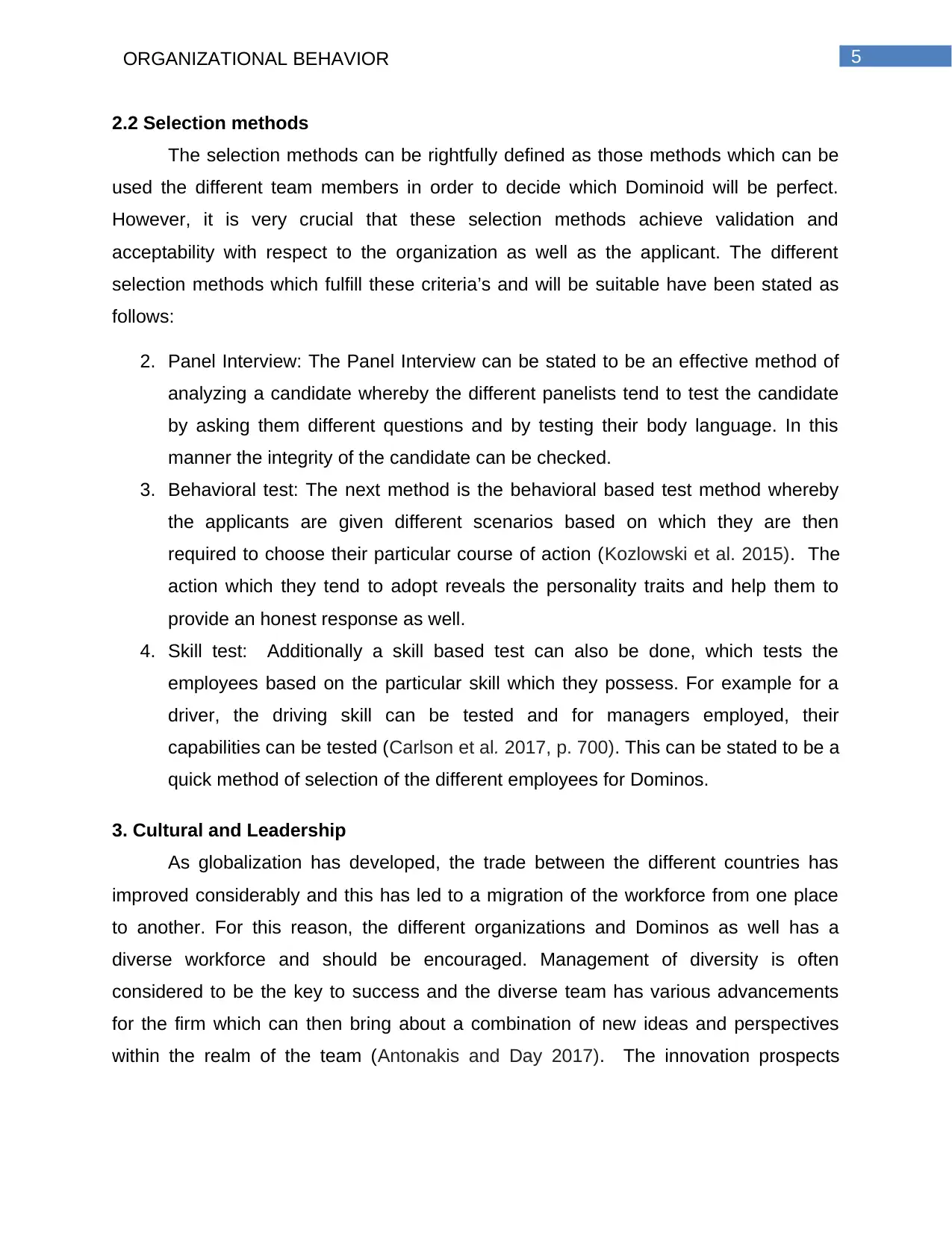
5ORGANIZATIONAL BEHAVIOR
2.2 Selection methods
The selection methods can be rightfully defined as those methods which can be
used the different team members in order to decide which Dominoid will be perfect.
However, it is very crucial that these selection methods achieve validation and
acceptability with respect to the organization as well as the applicant. The different
selection methods which fulfill these criteria’s and will be suitable have been stated as
follows:
2. Panel Interview: The Panel Interview can be stated to be an effective method of
analyzing a candidate whereby the different panelists tend to test the candidate
by asking them different questions and by testing their body language. In this
manner the integrity of the candidate can be checked.
3. Behavioral test: The next method is the behavioral based test method whereby
the applicants are given different scenarios based on which they are then
required to choose their particular course of action (Kozlowski et al. 2015). The
action which they tend to adopt reveals the personality traits and help them to
provide an honest response as well.
4. Skill test: Additionally a skill based test can also be done, which tests the
employees based on the particular skill which they possess. For example for a
driver, the driving skill can be tested and for managers employed, their
capabilities can be tested (Carlson et al. 2017, p. 700). This can be stated to be a
quick method of selection of the different employees for Dominos.
3. Cultural and Leadership
As globalization has developed, the trade between the different countries has
improved considerably and this has led to a migration of the workforce from one place
to another. For this reason, the different organizations and Dominos as well has a
diverse workforce and should be encouraged. Management of diversity is often
considered to be the key to success and the diverse team has various advancements
for the firm which can then bring about a combination of new ideas and perspectives
within the realm of the team (Antonakis and Day 2017). The innovation prospects
2.2 Selection methods
The selection methods can be rightfully defined as those methods which can be
used the different team members in order to decide which Dominoid will be perfect.
However, it is very crucial that these selection methods achieve validation and
acceptability with respect to the organization as well as the applicant. The different
selection methods which fulfill these criteria’s and will be suitable have been stated as
follows:
2. Panel Interview: The Panel Interview can be stated to be an effective method of
analyzing a candidate whereby the different panelists tend to test the candidate
by asking them different questions and by testing their body language. In this
manner the integrity of the candidate can be checked.
3. Behavioral test: The next method is the behavioral based test method whereby
the applicants are given different scenarios based on which they are then
required to choose their particular course of action (Kozlowski et al. 2015). The
action which they tend to adopt reveals the personality traits and help them to
provide an honest response as well.
4. Skill test: Additionally a skill based test can also be done, which tests the
employees based on the particular skill which they possess. For example for a
driver, the driving skill can be tested and for managers employed, their
capabilities can be tested (Carlson et al. 2017, p. 700). This can be stated to be a
quick method of selection of the different employees for Dominos.
3. Cultural and Leadership
As globalization has developed, the trade between the different countries has
improved considerably and this has led to a migration of the workforce from one place
to another. For this reason, the different organizations and Dominos as well has a
diverse workforce and should be encouraged. Management of diversity is often
considered to be the key to success and the diverse team has various advancements
for the firm which can then bring about a combination of new ideas and perspectives
within the realm of the team (Antonakis and Day 2017). The innovation prospects
⊘ This is a preview!⊘
Do you want full access?
Subscribe today to unlock all pages.

Trusted by 1+ million students worldwide
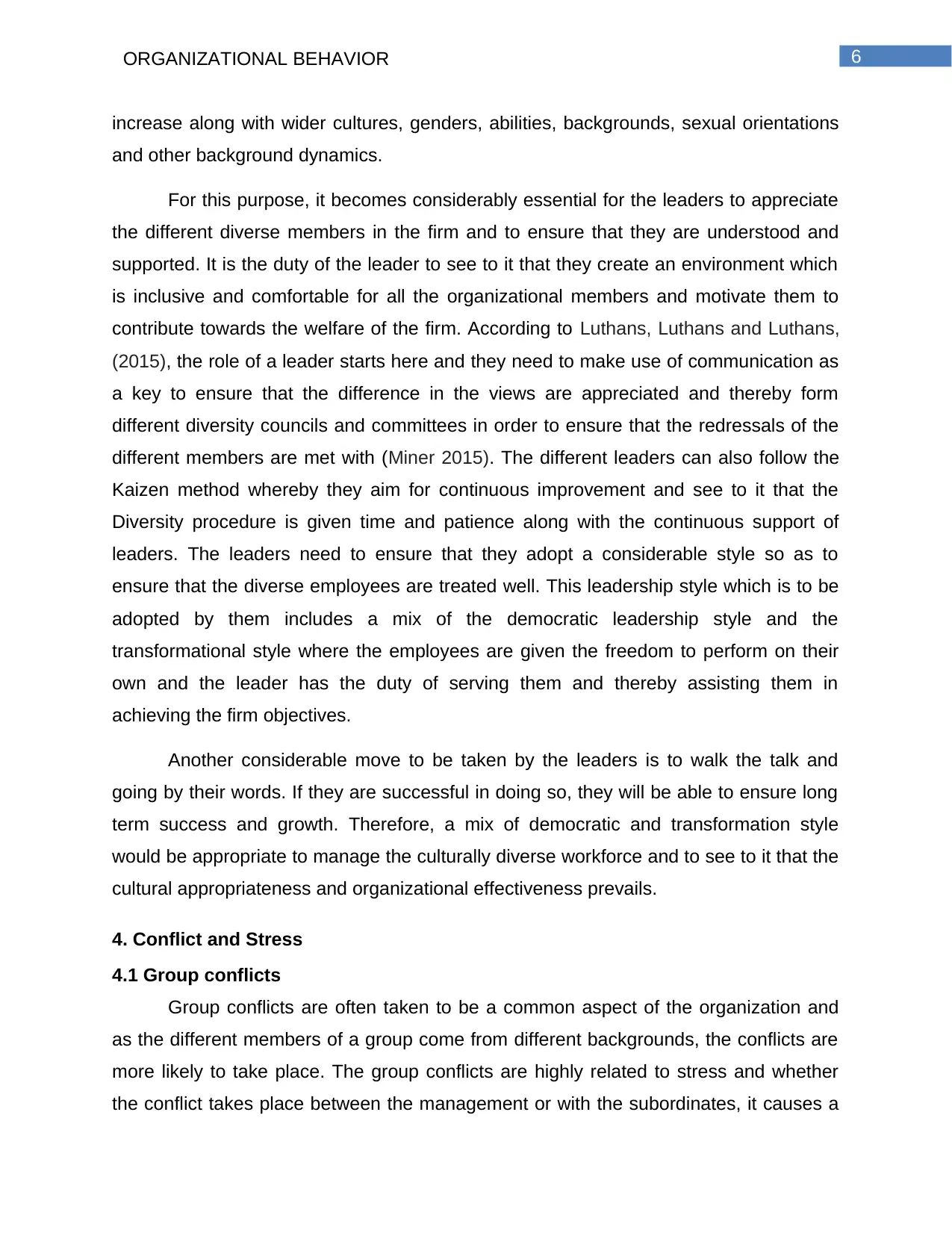
6ORGANIZATIONAL BEHAVIOR
increase along with wider cultures, genders, abilities, backgrounds, sexual orientations
and other background dynamics.
For this purpose, it becomes considerably essential for the leaders to appreciate
the different diverse members in the firm and to ensure that they are understood and
supported. It is the duty of the leader to see to it that they create an environment which
is inclusive and comfortable for all the organizational members and motivate them to
contribute towards the welfare of the firm. According to Luthans, Luthans and Luthans,
(2015), the role of a leader starts here and they need to make use of communication as
a key to ensure that the difference in the views are appreciated and thereby form
different diversity councils and committees in order to ensure that the redressals of the
different members are met with (Miner 2015). The different leaders can also follow the
Kaizen method whereby they aim for continuous improvement and see to it that the
Diversity procedure is given time and patience along with the continuous support of
leaders. The leaders need to ensure that they adopt a considerable style so as to
ensure that the diverse employees are treated well. This leadership style which is to be
adopted by them includes a mix of the democratic leadership style and the
transformational style where the employees are given the freedom to perform on their
own and the leader has the duty of serving them and thereby assisting them in
achieving the firm objectives.
Another considerable move to be taken by the leaders is to walk the talk and
going by their words. If they are successful in doing so, they will be able to ensure long
term success and growth. Therefore, a mix of democratic and transformation style
would be appropriate to manage the culturally diverse workforce and to see to it that the
cultural appropriateness and organizational effectiveness prevails.
4. Conflict and Stress
4.1 Group conflicts
Group conflicts are often taken to be a common aspect of the organization and
as the different members of a group come from different backgrounds, the conflicts are
more likely to take place. The group conflicts are highly related to stress and whether
the conflict takes place between the management or with the subordinates, it causes a
increase along with wider cultures, genders, abilities, backgrounds, sexual orientations
and other background dynamics.
For this purpose, it becomes considerably essential for the leaders to appreciate
the different diverse members in the firm and to ensure that they are understood and
supported. It is the duty of the leader to see to it that they create an environment which
is inclusive and comfortable for all the organizational members and motivate them to
contribute towards the welfare of the firm. According to Luthans, Luthans and Luthans,
(2015), the role of a leader starts here and they need to make use of communication as
a key to ensure that the difference in the views are appreciated and thereby form
different diversity councils and committees in order to ensure that the redressals of the
different members are met with (Miner 2015). The different leaders can also follow the
Kaizen method whereby they aim for continuous improvement and see to it that the
Diversity procedure is given time and patience along with the continuous support of
leaders. The leaders need to ensure that they adopt a considerable style so as to
ensure that the diverse employees are treated well. This leadership style which is to be
adopted by them includes a mix of the democratic leadership style and the
transformational style where the employees are given the freedom to perform on their
own and the leader has the duty of serving them and thereby assisting them in
achieving the firm objectives.
Another considerable move to be taken by the leaders is to walk the talk and
going by their words. If they are successful in doing so, they will be able to ensure long
term success and growth. Therefore, a mix of democratic and transformation style
would be appropriate to manage the culturally diverse workforce and to see to it that the
cultural appropriateness and organizational effectiveness prevails.
4. Conflict and Stress
4.1 Group conflicts
Group conflicts are often taken to be a common aspect of the organization and
as the different members of a group come from different backgrounds, the conflicts are
more likely to take place. The group conflicts are highly related to stress and whether
the conflict takes place between the management or with the subordinates, it causes a
Paraphrase This Document
Need a fresh take? Get an instant paraphrase of this document with our AI Paraphraser
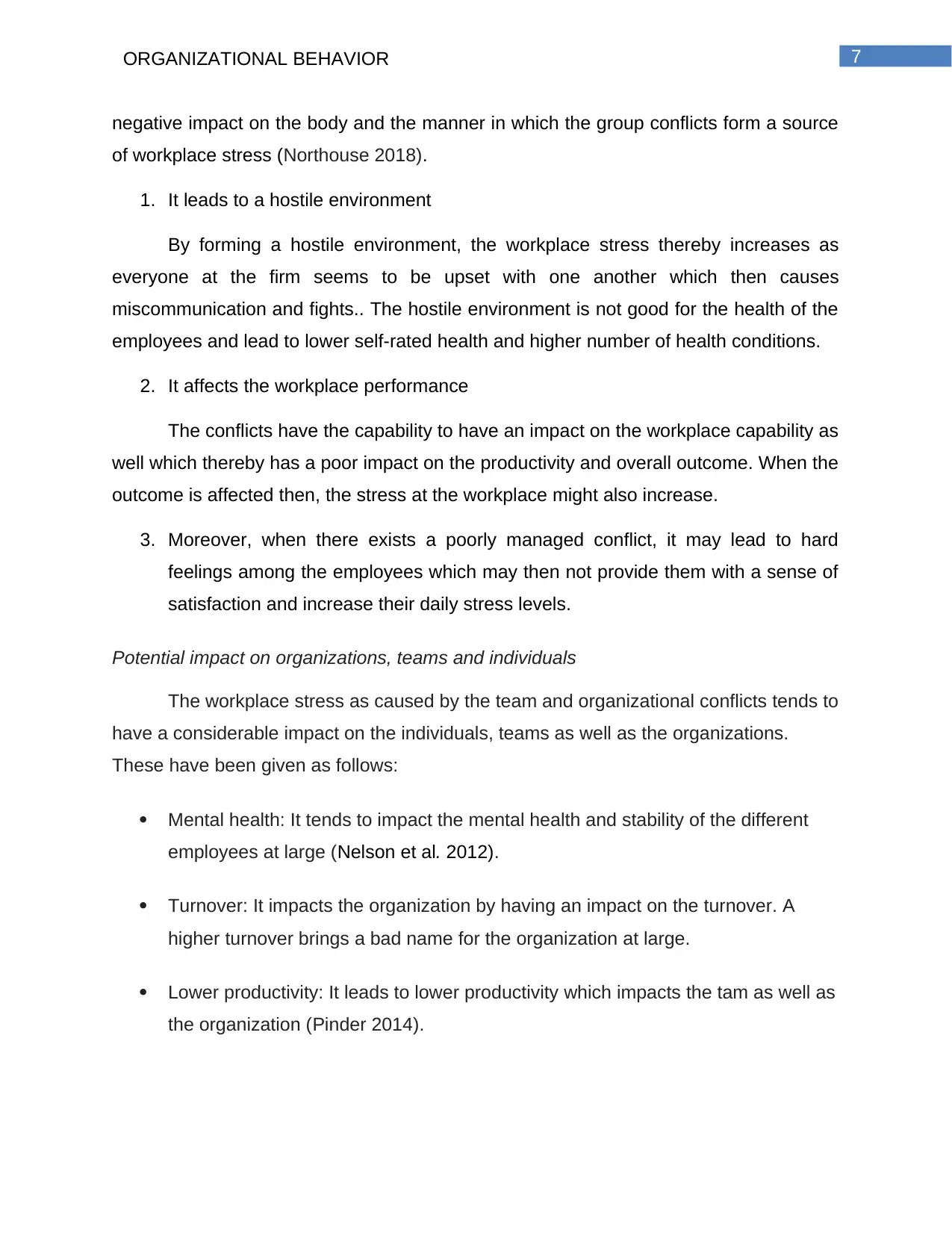
7ORGANIZATIONAL BEHAVIOR
negative impact on the body and the manner in which the group conflicts form a source
of workplace stress (Northouse 2018).
1. It leads to a hostile environment
By forming a hostile environment, the workplace stress thereby increases as
everyone at the firm seems to be upset with one another which then causes
miscommunication and fights.. The hostile environment is not good for the health of the
employees and lead to lower self-rated health and higher number of health conditions.
2. It affects the workplace performance
The conflicts have the capability to have an impact on the workplace capability as
well which thereby has a poor impact on the productivity and overall outcome. When the
outcome is affected then, the stress at the workplace might also increase.
3. Moreover, when there exists a poorly managed conflict, it may lead to hard
feelings among the employees which may then not provide them with a sense of
satisfaction and increase their daily stress levels.
Potential impact on organizations, teams and individuals
The workplace stress as caused by the team and organizational conflicts tends to
have a considerable impact on the individuals, teams as well as the organizations.
These have been given as follows:
Mental health: It tends to impact the mental health and stability of the different
employees at large (Nelson et al. 2012).
Turnover: It impacts the organization by having an impact on the turnover. A
higher turnover brings a bad name for the organization at large.
Lower productivity: It leads to lower productivity which impacts the tam as well as
the organization (Pinder 2014).
negative impact on the body and the manner in which the group conflicts form a source
of workplace stress (Northouse 2018).
1. It leads to a hostile environment
By forming a hostile environment, the workplace stress thereby increases as
everyone at the firm seems to be upset with one another which then causes
miscommunication and fights.. The hostile environment is not good for the health of the
employees and lead to lower self-rated health and higher number of health conditions.
2. It affects the workplace performance
The conflicts have the capability to have an impact on the workplace capability as
well which thereby has a poor impact on the productivity and overall outcome. When the
outcome is affected then, the stress at the workplace might also increase.
3. Moreover, when there exists a poorly managed conflict, it may lead to hard
feelings among the employees which may then not provide them with a sense of
satisfaction and increase their daily stress levels.
Potential impact on organizations, teams and individuals
The workplace stress as caused by the team and organizational conflicts tends to
have a considerable impact on the individuals, teams as well as the organizations.
These have been given as follows:
Mental health: It tends to impact the mental health and stability of the different
employees at large (Nelson et al. 2012).
Turnover: It impacts the organization by having an impact on the turnover. A
higher turnover brings a bad name for the organization at large.
Lower productivity: It leads to lower productivity which impacts the tam as well as
the organization (Pinder 2014).
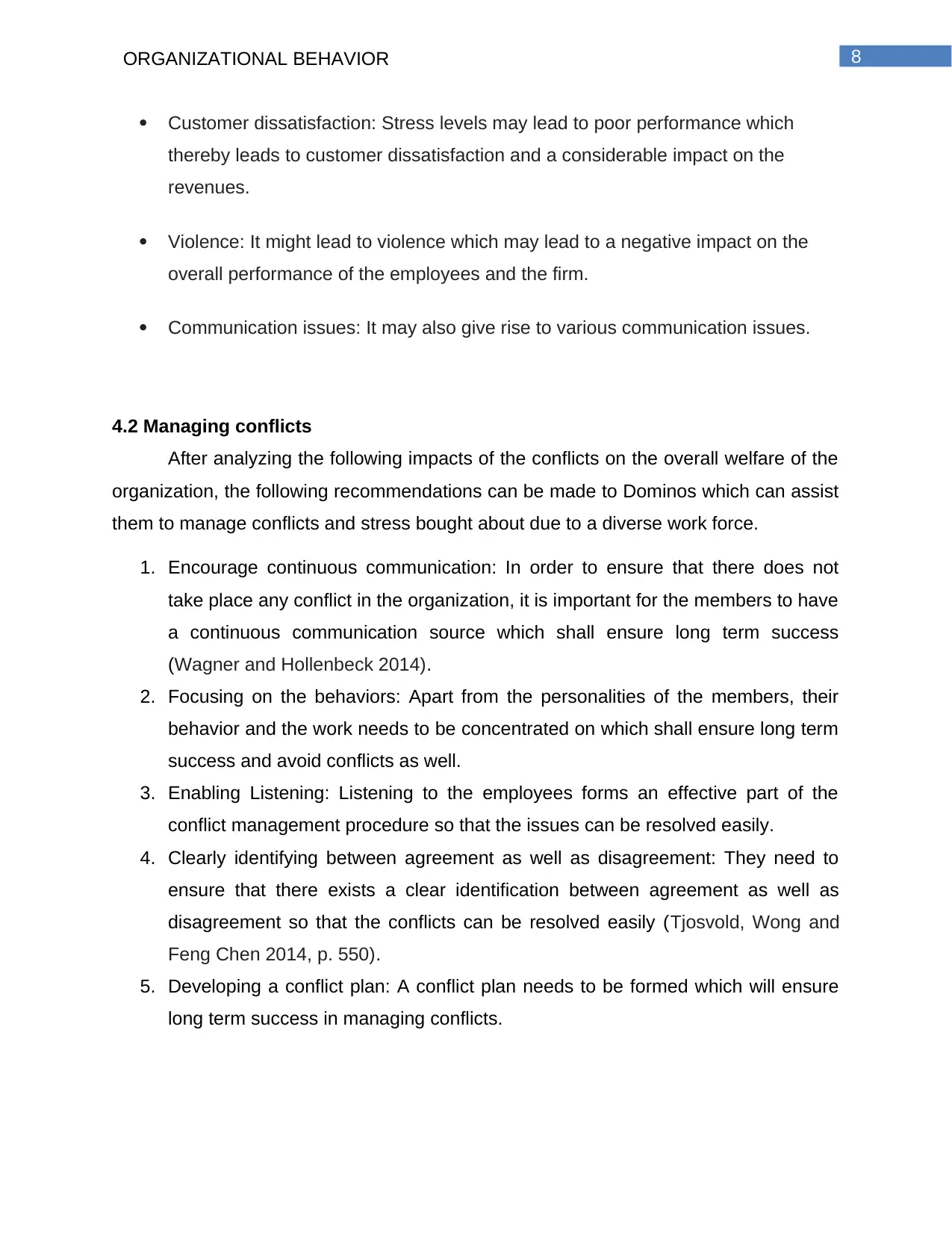
8ORGANIZATIONAL BEHAVIOR
Customer dissatisfaction: Stress levels may lead to poor performance which
thereby leads to customer dissatisfaction and a considerable impact on the
revenues.
Violence: It might lead to violence which may lead to a negative impact on the
overall performance of the employees and the firm.
Communication issues: It may also give rise to various communication issues.
4.2 Managing conflicts
After analyzing the following impacts of the conflicts on the overall welfare of the
organization, the following recommendations can be made to Dominos which can assist
them to manage conflicts and stress bought about due to a diverse work force.
1. Encourage continuous communication: In order to ensure that there does not
take place any conflict in the organization, it is important for the members to have
a continuous communication source which shall ensure long term success
(Wagner and Hollenbeck 2014).
2. Focusing on the behaviors: Apart from the personalities of the members, their
behavior and the work needs to be concentrated on which shall ensure long term
success and avoid conflicts as well.
3. Enabling Listening: Listening to the employees forms an effective part of the
conflict management procedure so that the issues can be resolved easily.
4. Clearly identifying between agreement as well as disagreement: They need to
ensure that there exists a clear identification between agreement as well as
disagreement so that the conflicts can be resolved easily (Tjosvold, Wong and
Feng Chen 2014, p. 550).
5. Developing a conflict plan: A conflict plan needs to be formed which will ensure
long term success in managing conflicts.
Customer dissatisfaction: Stress levels may lead to poor performance which
thereby leads to customer dissatisfaction and a considerable impact on the
revenues.
Violence: It might lead to violence which may lead to a negative impact on the
overall performance of the employees and the firm.
Communication issues: It may also give rise to various communication issues.
4.2 Managing conflicts
After analyzing the following impacts of the conflicts on the overall welfare of the
organization, the following recommendations can be made to Dominos which can assist
them to manage conflicts and stress bought about due to a diverse work force.
1. Encourage continuous communication: In order to ensure that there does not
take place any conflict in the organization, it is important for the members to have
a continuous communication source which shall ensure long term success
(Wagner and Hollenbeck 2014).
2. Focusing on the behaviors: Apart from the personalities of the members, their
behavior and the work needs to be concentrated on which shall ensure long term
success and avoid conflicts as well.
3. Enabling Listening: Listening to the employees forms an effective part of the
conflict management procedure so that the issues can be resolved easily.
4. Clearly identifying between agreement as well as disagreement: They need to
ensure that there exists a clear identification between agreement as well as
disagreement so that the conflicts can be resolved easily (Tjosvold, Wong and
Feng Chen 2014, p. 550).
5. Developing a conflict plan: A conflict plan needs to be formed which will ensure
long term success in managing conflicts.
⊘ This is a preview!⊘
Do you want full access?
Subscribe today to unlock all pages.

Trusted by 1+ million students worldwide
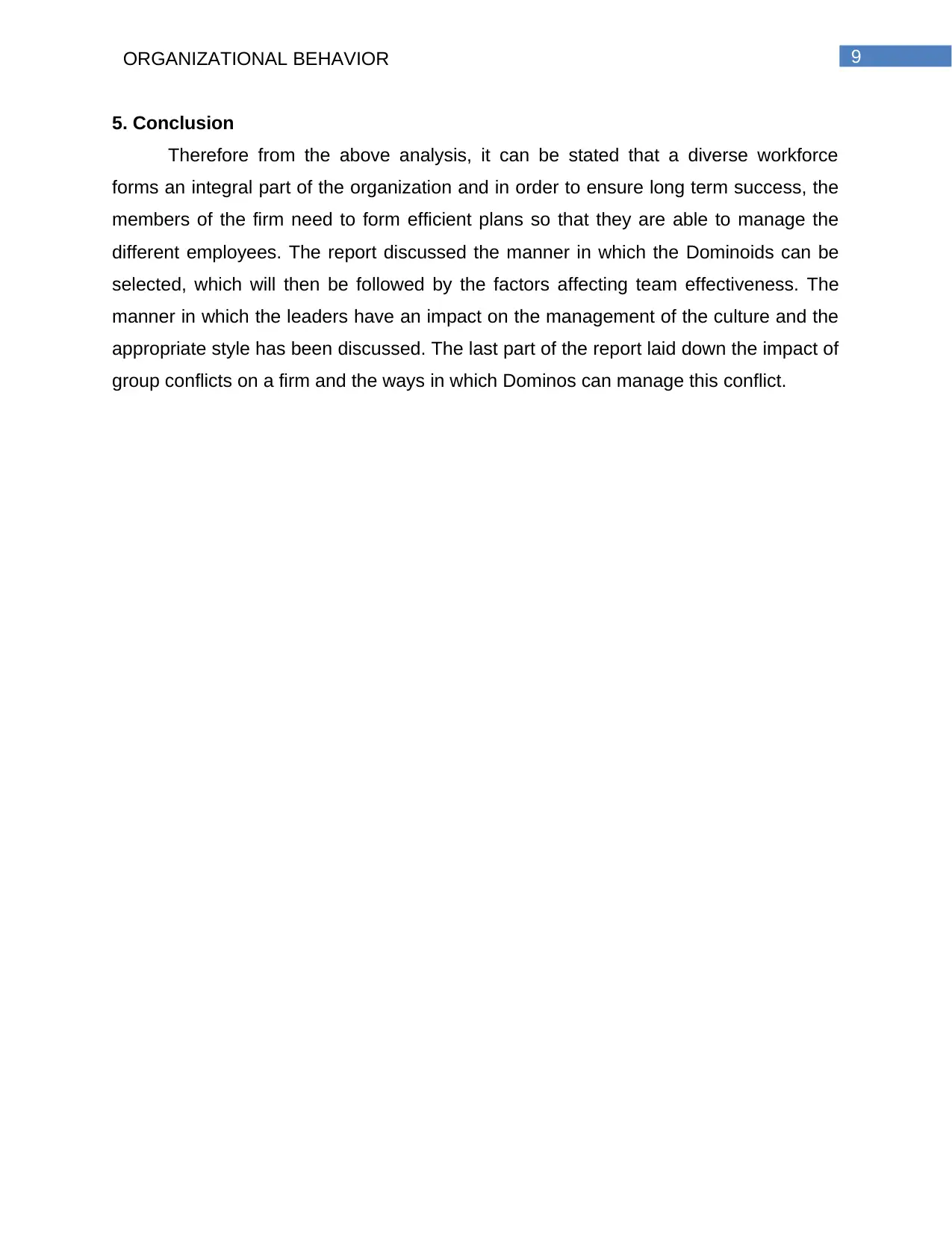
9ORGANIZATIONAL BEHAVIOR
5. Conclusion
Therefore from the above analysis, it can be stated that a diverse workforce
forms an integral part of the organization and in order to ensure long term success, the
members of the firm need to form efficient plans so that they are able to manage the
different employees. The report discussed the manner in which the Dominoids can be
selected, which will then be followed by the factors affecting team effectiveness. The
manner in which the leaders have an impact on the management of the culture and the
appropriate style has been discussed. The last part of the report laid down the impact of
group conflicts on a firm and the ways in which Dominos can manage this conflict.
5. Conclusion
Therefore from the above analysis, it can be stated that a diverse workforce
forms an integral part of the organization and in order to ensure long term success, the
members of the firm need to form efficient plans so that they are able to manage the
different employees. The report discussed the manner in which the Dominoids can be
selected, which will then be followed by the factors affecting team effectiveness. The
manner in which the leaders have an impact on the management of the culture and the
appropriate style has been discussed. The last part of the report laid down the impact of
group conflicts on a firm and the ways in which Dominos can manage this conflict.
Paraphrase This Document
Need a fresh take? Get an instant paraphrase of this document with our AI Paraphraser
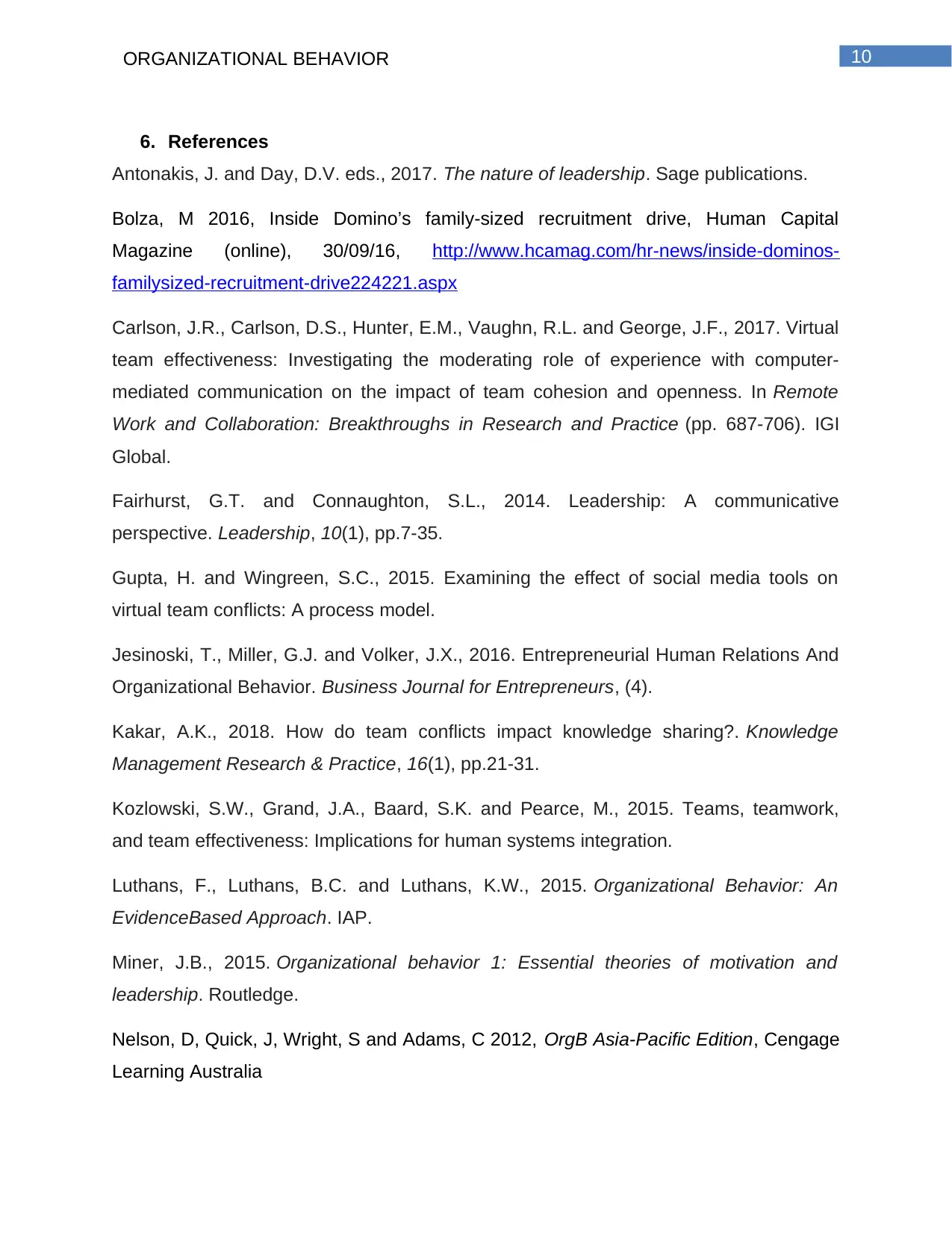
10ORGANIZATIONAL BEHAVIOR
6. References
Antonakis, J. and Day, D.V. eds., 2017. The nature of leadership. Sage publications.
Bolza, M 2016, Inside Domino’s family-sized recruitment drive, Human Capital
Magazine (online), 30/09/16, http://www.hcamag.com/hr-news/inside-dominos-
familysized-recruitment-drive224221.aspx
Carlson, J.R., Carlson, D.S., Hunter, E.M., Vaughn, R.L. and George, J.F., 2017. Virtual
team effectiveness: Investigating the moderating role of experience with computer-
mediated communication on the impact of team cohesion and openness. In Remote
Work and Collaboration: Breakthroughs in Research and Practice (pp. 687-706). IGI
Global.
Fairhurst, G.T. and Connaughton, S.L., 2014. Leadership: A communicative
perspective. Leadership, 10(1), pp.7-35.
Gupta, H. and Wingreen, S.C., 2015. Examining the effect of social media tools on
virtual team conflicts: A process model.
Jesinoski, T., Miller, G.J. and Volker, J.X., 2016. Entrepreneurial Human Relations And
Organizational Behavior. Business Journal for Entrepreneurs, (4).
Kakar, A.K., 2018. How do team conflicts impact knowledge sharing?. Knowledge
Management Research & Practice, 16(1), pp.21-31.
Kozlowski, S.W., Grand, J.A., Baard, S.K. and Pearce, M., 2015. Teams, teamwork,
and team effectiveness: Implications for human systems integration.
Luthans, F., Luthans, B.C. and Luthans, K.W., 2015. Organizational Behavior: An
EvidenceBased Approach. IAP.
Miner, J.B., 2015. Organizational behavior 1: Essential theories of motivation and
leadership. Routledge.
Nelson, D, Quick, J, Wright, S and Adams, C 2012, OrgB Asia-Pacific Edition, Cengage
Learning Australia
6. References
Antonakis, J. and Day, D.V. eds., 2017. The nature of leadership. Sage publications.
Bolza, M 2016, Inside Domino’s family-sized recruitment drive, Human Capital
Magazine (online), 30/09/16, http://www.hcamag.com/hr-news/inside-dominos-
familysized-recruitment-drive224221.aspx
Carlson, J.R., Carlson, D.S., Hunter, E.M., Vaughn, R.L. and George, J.F., 2017. Virtual
team effectiveness: Investigating the moderating role of experience with computer-
mediated communication on the impact of team cohesion and openness. In Remote
Work and Collaboration: Breakthroughs in Research and Practice (pp. 687-706). IGI
Global.
Fairhurst, G.T. and Connaughton, S.L., 2014. Leadership: A communicative
perspective. Leadership, 10(1), pp.7-35.
Gupta, H. and Wingreen, S.C., 2015. Examining the effect of social media tools on
virtual team conflicts: A process model.
Jesinoski, T., Miller, G.J. and Volker, J.X., 2016. Entrepreneurial Human Relations And
Organizational Behavior. Business Journal for Entrepreneurs, (4).
Kakar, A.K., 2018. How do team conflicts impact knowledge sharing?. Knowledge
Management Research & Practice, 16(1), pp.21-31.
Kozlowski, S.W., Grand, J.A., Baard, S.K. and Pearce, M., 2015. Teams, teamwork,
and team effectiveness: Implications for human systems integration.
Luthans, F., Luthans, B.C. and Luthans, K.W., 2015. Organizational Behavior: An
EvidenceBased Approach. IAP.
Miner, J.B., 2015. Organizational behavior 1: Essential theories of motivation and
leadership. Routledge.
Nelson, D, Quick, J, Wright, S and Adams, C 2012, OrgB Asia-Pacific Edition, Cengage
Learning Australia
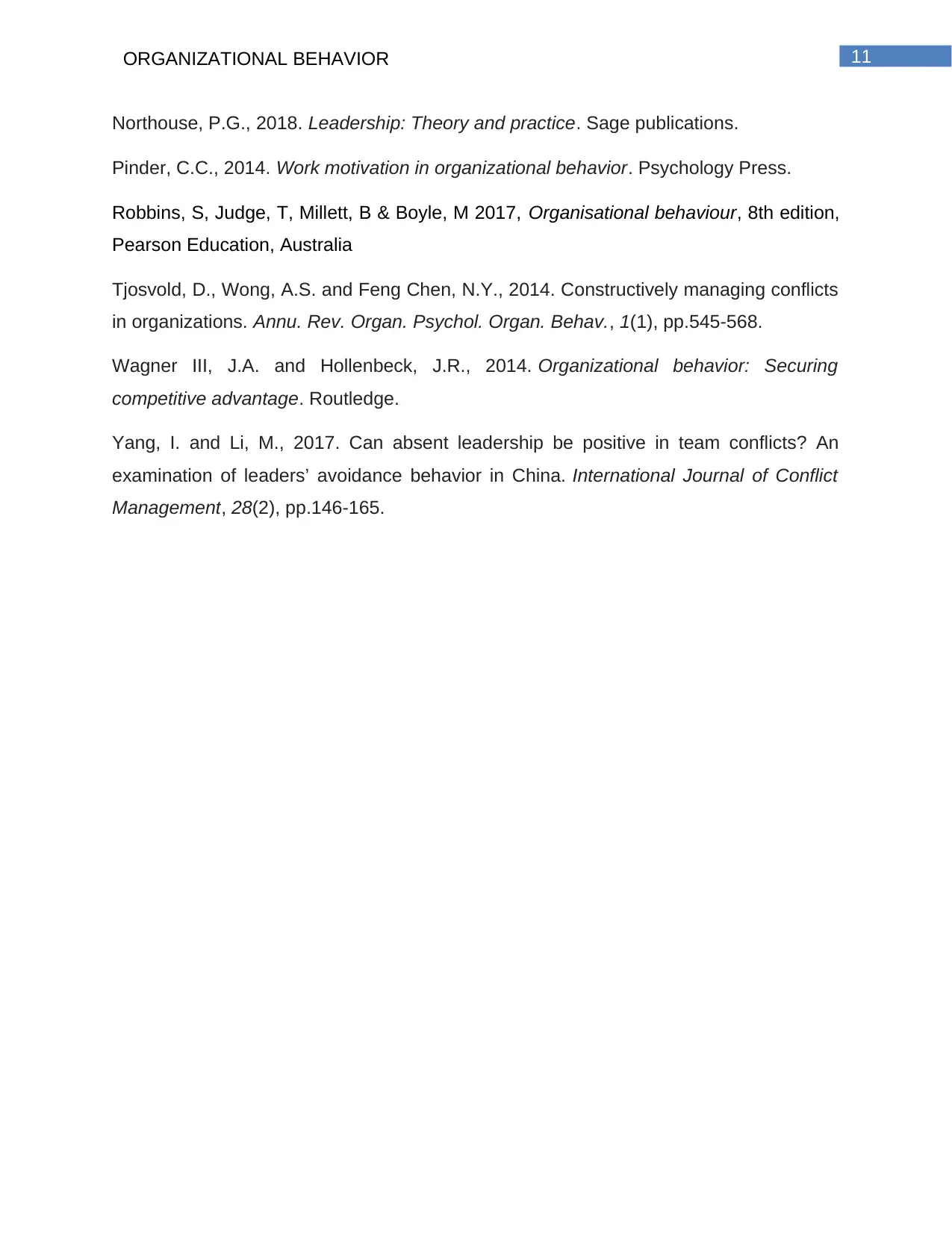
11ORGANIZATIONAL BEHAVIOR
Northouse, P.G., 2018. Leadership: Theory and practice. Sage publications.
Pinder, C.C., 2014. Work motivation in organizational behavior. Psychology Press.
Robbins, S, Judge, T, Millett, B & Boyle, M 2017, Organisational behaviour, 8th edition,
Pearson Education, Australia
Tjosvold, D., Wong, A.S. and Feng Chen, N.Y., 2014. Constructively managing conflicts
in organizations. Annu. Rev. Organ. Psychol. Organ. Behav., 1(1), pp.545-568.
Wagner III, J.A. and Hollenbeck, J.R., 2014. Organizational behavior: Securing
competitive advantage. Routledge.
Yang, I. and Li, M., 2017. Can absent leadership be positive in team conflicts? An
examination of leaders’ avoidance behavior in China. International Journal of Conflict
Management, 28(2), pp.146-165.
Northouse, P.G., 2018. Leadership: Theory and practice. Sage publications.
Pinder, C.C., 2014. Work motivation in organizational behavior. Psychology Press.
Robbins, S, Judge, T, Millett, B & Boyle, M 2017, Organisational behaviour, 8th edition,
Pearson Education, Australia
Tjosvold, D., Wong, A.S. and Feng Chen, N.Y., 2014. Constructively managing conflicts
in organizations. Annu. Rev. Organ. Psychol. Organ. Behav., 1(1), pp.545-568.
Wagner III, J.A. and Hollenbeck, J.R., 2014. Organizational behavior: Securing
competitive advantage. Routledge.
Yang, I. and Li, M., 2017. Can absent leadership be positive in team conflicts? An
examination of leaders’ avoidance behavior in China. International Journal of Conflict
Management, 28(2), pp.146-165.
⊘ This is a preview!⊘
Do you want full access?
Subscribe today to unlock all pages.

Trusted by 1+ million students worldwide
1 out of 12
Related Documents
Your All-in-One AI-Powered Toolkit for Academic Success.
+13062052269
info@desklib.com
Available 24*7 on WhatsApp / Email
![[object Object]](/_next/static/media/star-bottom.7253800d.svg)
Unlock your academic potential
Copyright © 2020–2025 A2Z Services. All Rights Reserved. Developed and managed by ZUCOL.




